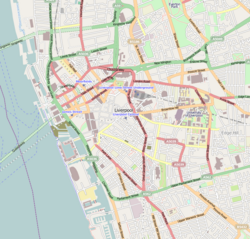History
The road is situated on what was the site of Lyver Pool, a natural creek that made up the original dock for Liverpool. [1] The land was originally known as 'Common Shore', and the area was a described as an 'evil-smelling swamp' and sewer by historian Thomas Troughton in his 1802 book on Liverpool's history. [2]
In 1643, during the English Civil War, Colonel John Moore created a garrison for Parliamentary forces which had gun batteries set up along Paradise Street and Whitechapel. [3]
A bridge across the Pool was built in 1672. [4] The remains of the bridge, situated where the McDonald's restaurant new stands, were unearthed after World War 2 when rebuilding took place.
During the 1730s, Thomas Steers - the engineer who built Liverpool's first dock, owned land on Common Shore. [5] He chose to name the land 'Paradise Street' after the street he once lived on in Rotherhithe, London.
A Holiday Inn was opened on the street in 1973 (later known as the 'Moat House Hotel'), which welcomed guests including Oliver Reed, Richard Harris, Julie Dench and John Travolta. [6] The hotel closed in December 2004 and was demolished in spring 2005.
The bus station on Paradise Street was demolished in 2006 as part of the Liverpool One development. [7] A replacement bus station was built on Canning Place, opening in June 2005.
In August 2011, the gates to the former Liverpool Sailors' Home were re-erected on the pedestrian section of the street, close to where the original site of the sailor's home was. [8] [9]
This page is based on this
Wikipedia article Text is available under the
CC BY-SA 4.0 license; additional terms may apply.
Images, videos and audio are available under their respective licenses.

